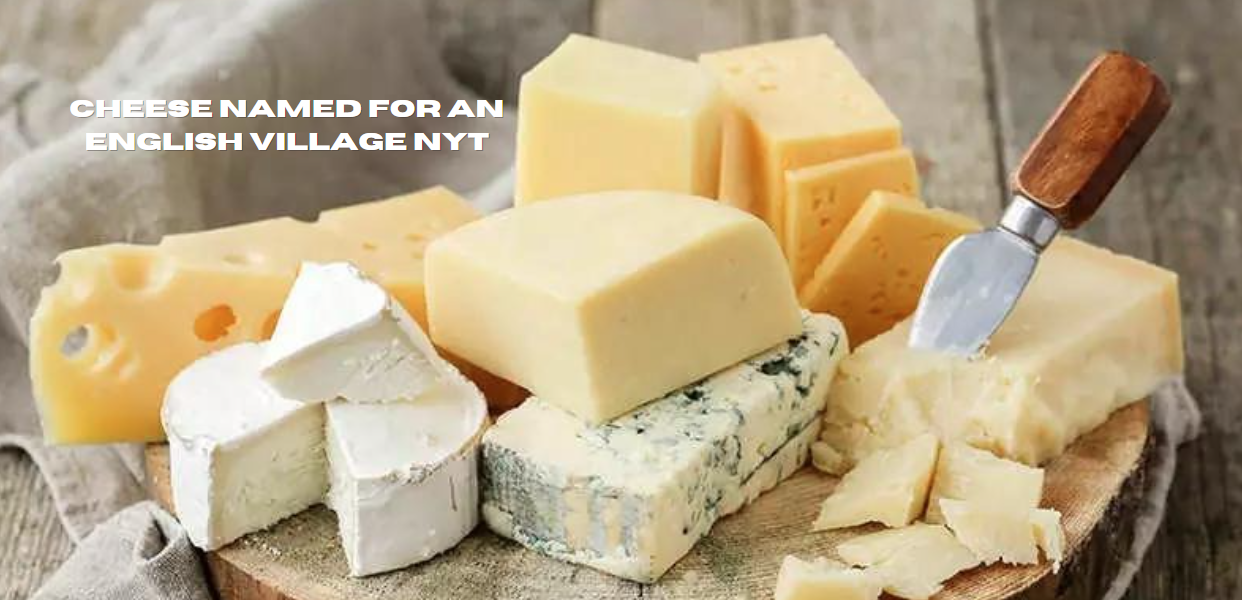Cheese Named for an English Village NYT: A Deep Dive into England’s Rich Cheesemaking Heritage
Contents
- 1 Introduction
- 2 The Importance of Village Cheese in English Culture
- 3 Exploring the Crossword Clue: “Cheese Named for an English Village”
- 4 Other Notable English Village Cheeses
- 5 The Cultural and Economic Impact of Village-Named Cheeses
- 6 Conclusion: The Enduring Legacy of English Village-Named Cheeses
- 7 FAQs About “Cheese Named for an English Village NYT”
Introduction
When it comes to world-renowned cheeses, England stands as a formidable force, boasting a rich history that intertwines the art of cheesemaking with its pastoral landscapes. One of the most iconic references to this heritage recently came up in the form of a crossword clue in The New York Times: “Cheese named for an English village.” This clue has left many puzzlers and cheese aficionados alike intrigued, not just by the crossword challenge but by the deeper cultural and historical significance behind it.
In this article, we will explore the world of English village cheeses, delving into their origins, the unique characteristics that set them apart, and the particular village that has become synonymous with one of the world’s most beloved cheeses. Our goal is to provide an insightful and comprehensive guide that goes beyond the basics, offering unique interpretations and analyses that elevate your understanding of these celebrated cheeses.
The Importance of Village Cheese in English Culture
Cheesemaking in England is more than just a craft; it is a tradition that reflects the country’s agrarian roots and culinary evolution. The practice dates back centuries, with many cheeses being named after the villages or towns where they were originally produced. These cheeses were not just local delicacies but also symbols of regional pride and identity.
Village-named cheeses often embody the terroir, the “taste of place,” which includes the local climate, soil, and flora, all of which influence the flavor and texture of the cheese. This connection to the land and community gives these cheeses a unique character that cannot be replicated elsewhere.
Exploring the Crossword Clue: “Cheese Named for an English Village”
The New York Times crossword clue “Cheese named for an English village” might seem straightforward, but it opens the door to a fascinating exploration of England’s cheese heritage. The most likely answer to this clue is “Stilton,” a name that immediately evokes images of a quintessentially English village and a cheese that has achieved international acclaim.
Stilton: The King of English Cheeses
Origin and History Stilton cheese traces its origins to the 18th century, with its name deriving from the village of Stilton in Cambridgeshire. However, this is somewhat misleading, as the cheese was never actually made in Stilton. Instead, it was first produced in the nearby counties of Leicestershire, Nottinghamshire, and Derbyshire, and sold in Stilton, which was a popular stop for travelers along the Great North Road.
Stilton quickly gained fame for its rich, creamy texture and distinctive blue veins, which result from the introduction of Penicillium roqueforti mold during the cheesemaking process. By the late 18th century, it had become one of England’s most popular cheeses, with notable admirers including Daniel Defoe, who famously referred to Stilton as the “English Parmesan.”
Protected Designation of Origin (PDO) Stilton’s reputation is so esteemed that it was granted Protected Designation of Origin (PDO) status in 1996 by the European Union. This status ensures that only cheese made in the traditional manner within the specified counties can be labeled as Stilton. The PDO also stipulates that the milk used must be sourced from the same region, further anchoring Stilton to its geographical roots.
Varieties of Stilton There are two main varieties of Stilton: Blue Stilton and White Stilton. Blue Stilton is the more famous of the two, characterized by its rich, tangy flavor and iconic blue marbling. White Stilton, on the other hand, is a milder, crumbly cheese that lacks the blue veins but is often infused with fruits and other flavorings to create unique varieties.
Other Notable English Village Cheeses
While Stilton may be the most famous village-named cheese, it is by no means the only one. England boasts a plethora of other cheeses named after villages, each with its own story and distinctive qualities. Let’s explore a few more of these regional treasures.
Cheddar: The World’s Most Popular Cheese
Origin and History Cheddar cheese, arguably the world’s most famous cheese, takes its name from the village of Cheddar in Somerset. The village lies in the heart of the West Country, an area known for its lush pastures and ideal cheesemaking conditions. Cheddar has been produced since at least the 12th century and is believed to have originated in the caves of the Cheddar Gorge, where the cool, consistent temperature provided perfect aging conditions.
The Cheddar-Making Process Traditional Cheddar is made using a process known as “cheddaring,” where the curds are cut, stacked, and turned to drain excess whey. This method gives Cheddar its firm texture and allows it to be aged for varying lengths of time, resulting in cheeses ranging from mild to extra mature.
Global Influence Today, Cheddar is produced worldwide, but authentic West Country Farmhouse Cheddar, which is made using traditional methods in Somerset, Dorset, Devon, and Cornwall, holds a PDO status. This cheese is prized for its complex, nutty flavor and dense, crumbly texture.
Red Leicester: A Cheese of Distinction
Origin and History Red Leicester is another cheese with roots in English village life, named after the county of Leicestershire, where it was originally made. The cheese dates back to the 17th century and was initially produced as a means to extend the life of surplus milk.
Characteristics and Flavor Profile Red Leicester is known for its vibrant orange-red color, which comes from the addition of annatto, a natural dye derived from the seeds of the achiote tree. The cheese has a smooth, firm texture and a slightly sweet, nutty flavor that intensifies with age.
Cultural Significance Red Leicester has long been a staple in English households, often used in cooking and as a table cheese. It is also a popular choice for cheeseboards, where its striking color and rich flavor make it a standout.
Wensleydale: A Taste of Yorkshire
Origin and History Wensleydale cheese originates from the village of Hawes in Wensleydale, a valley in the Yorkshire Dales. The cheese has a history that dates back to the 12th century when Cistercian monks settled in the region and began making cheese using sheep’s milk.
Characteristics and Varieties Traditional Wensleydale cheese is crumbly and moist, with a slightly tangy flavor that pairs beautifully with fruits like apples and cranberries. There are also flavored varieties, including the famous Yorkshire Wensleydale with Cranberries.
Revival and Popularity Wensleydale was once at risk of disappearing, but a revival in the 20th century, thanks in part to its association with the popular British animated duo Wallace and Gromit, has ensured its place as a beloved English cheese.
The Cultural and Economic Impact of Village-Named Cheeses
Village-named cheeses like Stilton, Cheddar, and Wensleydale are more than just food products; they are cultural icons that represent the history, traditions, and identity of their respective regions. These cheeses play a significant role in the local economy, attracting tourists and contributing to the preservation of traditional farming and cheesemaking practices.
In many cases, the production of these cheeses supports small-scale dairy farmers and artisans who continue to use traditional methods passed down through generations. This commitment to quality and heritage not only preserves the unique flavors of these cheeses but also sustains the rural communities that produce them.
The Rise of Artisan Cheesemaking in England
In recent years, there has been a resurgence of interest in artisan cheesemaking in England, with many small producers reviving traditional recipes and experimenting with new techniques. This renaissance has led to the creation of a wide variety of village-named cheeses, some of which have gained international recognition.
Examples of Artisan Village-Named Cheeses
Tunworth Tunworth is an English cheese that has gained a reputation as the country’s answer to Camembert. Named after the village of Tunworth in Hampshire, this soft, bloomy-rinded cheese is made using unpasteurized cow’s milk and is known for its rich, earthy flavor and creamy texture.
Cornish Yarg Cornish Yarg is a semi-hard cheese from Cornwall, named after Alan Gray, who discovered the recipe in the 1980s (Yarg is Gray spelled backward). The cheese is wrapped in nettle leaves, which impart a unique, tangy flavor and help preserve the cheese as it matures.
Lincolnshire Poacher Lincolnshire Poacher is a hard cheese from Lincolnshire that combines the best elements of Cheddar and Alpine cheeses. Made using traditional methods and milk from the producer’s own herd of cows, it has a complex, nutty flavor with hints of sweetness and acidity.
Challenges Facing Traditional Village-Named Cheeses
While the resurgence of artisan cheesemaking is a positive development, traditional village-named cheeses still face significant challenges. Globalization and industrialization have led to the mass production of cheeses that often lack the distinct character of their artisan counterparts. Additionally, changes in agricultural practices and environmental pressures pose a threat to the sustainability of traditional cheesemaking.
The Impact of Industrialization
Industrialized cheesemaking processes prioritize efficiency and uniformity over flavor and quality. This has led to the proliferation of generic, mass-produced cheeses that dominate supermarket shelves, often overshadowing traditional village-named varieties. The rise of these industrial cheeses has also contributed to the decline of small-scale dairies and the loss of traditional knowledge and skills.
Environmental Challenges
Climate change and environmental degradation are also affecting the production of traditional cheeses. Changes in weather patterns can impact the quality and availability of the milk used in cheesemaking, while pollution and habitat loss threaten the biodiversity that contributes to the unique flavors of these cheeses.
The Future of Village-Named Cheeses
Despite these challenges, there is hope for the future of village-named cheeses. The growing interest in local, sustainable food has led to increased demand for artisan cheeses, and many consumers are willing to pay a premium for products that are made with care and respect for tradition.
The Role of Education and Advocacy
Education and advocacy are crucial to preserving and promoting traditional village-named cheeses. By raising awareness of the cultural and environmental importance of these cheeses, producers, retailers, and consumers can work together to support the continued production of these unique and irreplaceable foods.
Innovations in Cheesemaking
Innovation also has a role to play in the future of village-named cheeses. By embracing new technologies and techniques, while still honoring traditional methods, cheesemakers can create products that meet the demands of modern consumers without sacrificing quality or authenticity.
Conclusion: The Enduring Legacy of English Village-Named Cheeses
The crossword clue “Cheese named for an English village” is more than just a puzzle to be solved; it is a gateway to understanding the rich history and cultural significance of England’s cheesemaking heritage. From the world-famous Stilton to lesser-known but equally cherished varieties like Red Leicester and Wensleydale, these cheeses are a testament to the enduring connection between food, place, and community.
As we look to the future, it is essential to recognize the value of preserving traditional village-named cheeses, not just for their unique flavors but for the cultural heritage they represent. By supporting local producers, advocating for sustainable practices, and continuing to explore the diverse world of cheese, we can ensure that these iconic foods remain a cherished part of our culinary landscape for generations to come.
FAQs About “Cheese Named for an English Village NYT”
Q: What is the most famous cheese named for an English village?
A: The most famous cheese named for an English village is Stilton, often referred to as the “King of English Cheeses.”
Q: Why is Stilton cheese named after a village where it was not produced?
A: Stilton cheese is named after the village of Stilton because it was sold there by travelers along the Great North Road, even though it was originally produced in nearby counties.
Q: What other English cheeses are named after villages?
A: Other notable English cheeses named after villages include Cheddar (from Cheddar, Somerset), Red Leicester (from Leicestershire), and Wensleydale (from Wensleydale, Yorkshire).
Q: What is the significance of Protected Designation of Origin (PDO) status for cheeses?
A: PDO status protects the name of a product, ensuring that only cheese produced in a specific region using traditional methods can be labeled as such. This helps preserve the unique characteristics and heritage of the cheese.
Q: How can I support traditional village-named cheeses?
A: You can support traditional village-named cheeses by purchasing them from local producers, advocating for sustainable food practices, and educating others about the importance of preserving these cultural treasures.













































